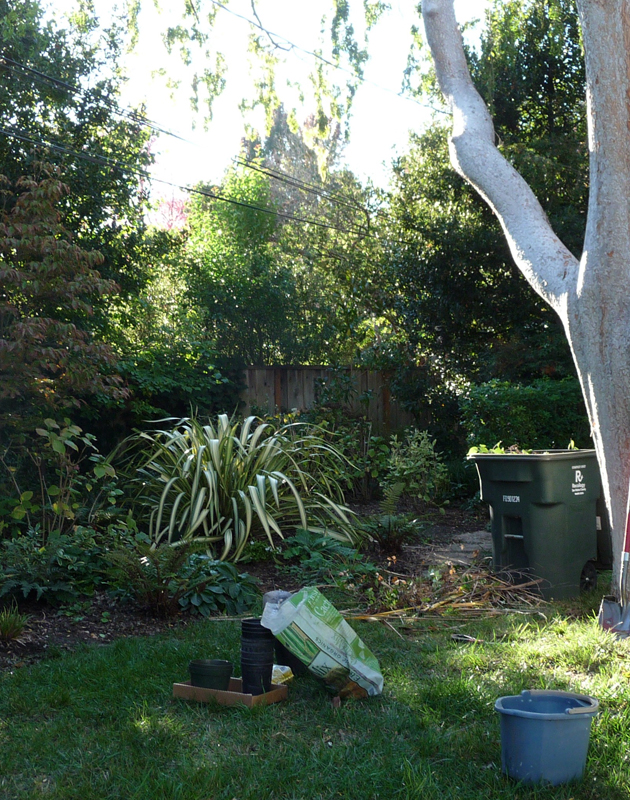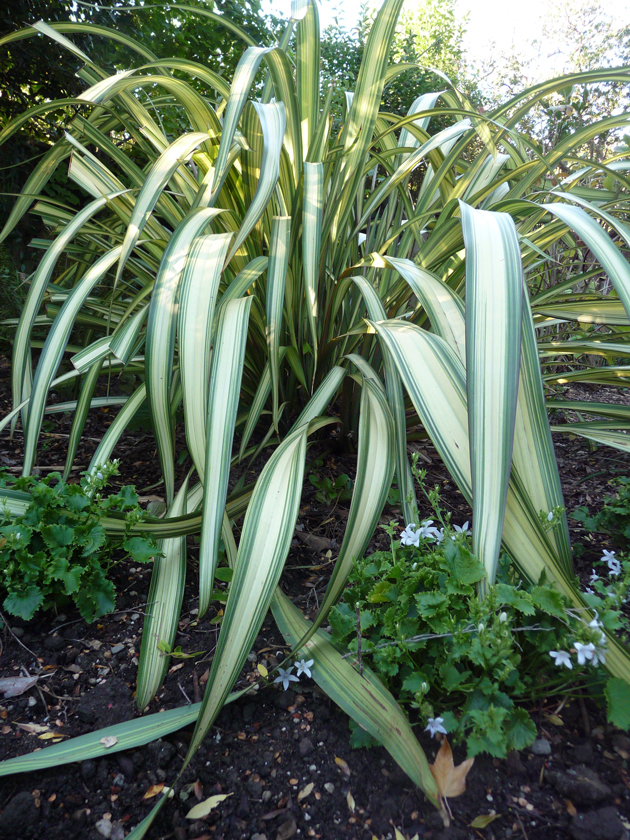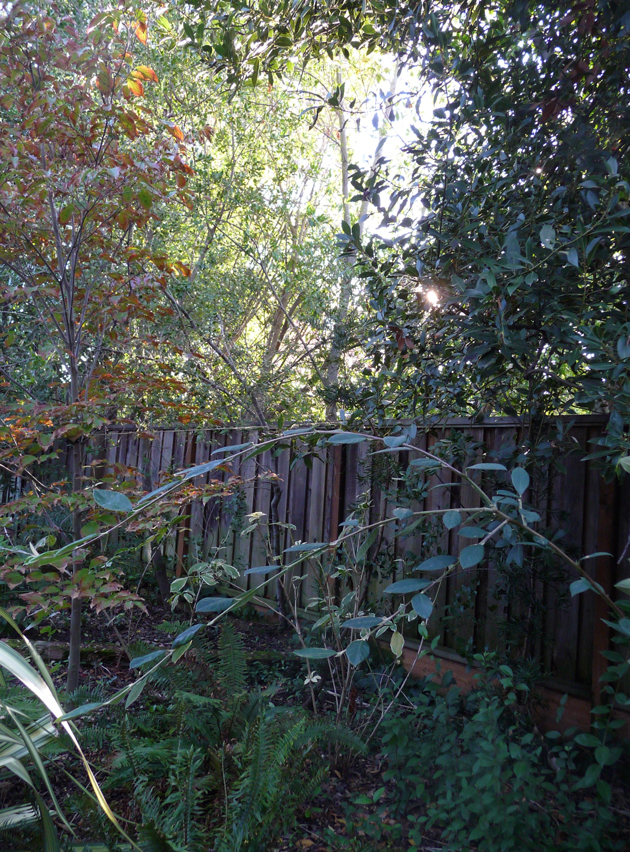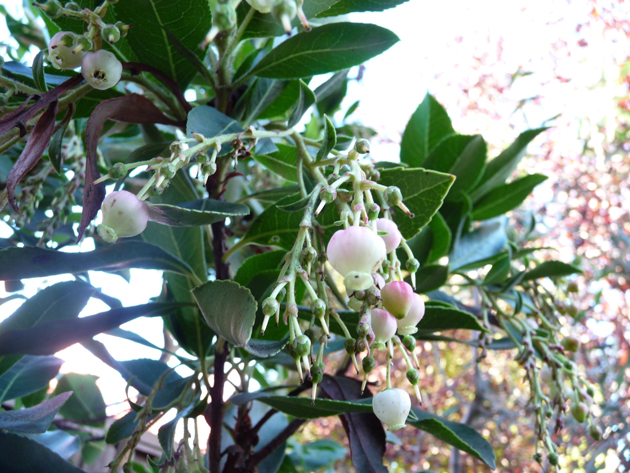
What if a genius landed in your garden, but, only stayed a couple of days?
Last week, Jeff S., he who designed my yard 15 years ago, came to visit. He lives in Seattle now, working by word of mouth for clients who share his aesthetic and philosophy. He comes to visit us Californians every once in a while.
I thought I knew what I wanted. The drought, and the years of neglect, replanting, transplanting had worn away at my garden’s structure. Much as I love to work on a small scale, I felt uncertain about landscape design, and I hoped Jeff might add some Big Plants For Big Impact.
We talked, ate lunch, considered. He shopped, I did too. He dug a lot of holes, I dug one. What? Holes are harder than they look.
In the end, I was surprised. Experts avoid the obvious. This is certainly true in personal style (you don’t often match your shoes exactly to your bag, do you?) and also, I’m beginning to discover, in interior design. Non-obvious changes of note included:

Nestling a few bellflowers (campanula) underneath my big showy New Zealand flax (phormium). Like pats of butter to glossy up a sauce. The blue-white of the campanula fights with the cream phormium, just enough. Like lemon, in that same sauce.

Staking the arching branches of a cotoneaster so they are visible behind but above the flax plant. Adding depth and layers of movement, but no more plants.

Replanting a couple of newly planted trees in the side yard so that the olives could catch as much sun as possible. Adding a third “strawberry tree,” (hybrid of arbutus madrone.) Some trees just look better in groves, even when teeny and suburban.
We made at least 10 other small changes, moving, subtracting, adding plants. But let’s move on to big lessons. 7, in fact.
7 Lessons From A Genius of Landscape Design
- Think vertically as well as horizontally (It would not have occurred to me that I needed campanula.)
- Nowhere does “the eye has to travel” mean more than in a garden (We decided to let one path go altogether, so the garden flowed more purely toward the big flax plant.)
- Respect your plants (We moved unhappy sword ferns farther back, planted some other, more suitable varieties closer up. Related, need to water the hydrangeas more often.)
- Respect your soil and all its inhabitants (We planted gardenia and jasmine, but in pots. Turns out my neighbors’ enormous cypress is responsible for that intractable empty spot. Nothing will ever manage to grow there.)
- Step back, experiment, do both more and less than you thought, learn your garden style by saying yes to the experts a little bit more often than you want to. At first. (I made some tradeoffs between native plants and useful ones. We shall see how it turns out.)
- Think across time (I have a volunteer palm in the side yard. For now it’s staying. We moved a tea tree out from under some shade (leptospermum), to a contiguous sunny spot. We shall see how palm and tea interact over the next 5-10 years.)
- Be prepared to choose one dream over another (I wanted a butterfly garden in the side yard. I also wanted the discipline and architectural serenity of a minimal plant palette. Butterflies won.)
And now to the lesson so important it shrugs off its number:
Waiting is a joy.
I’ll be here until early spring, finding beauty in “ruined choirs,” as Shakespeare calls trees without leaves. I’ll clap for red berries, those non-obvious changes plants make for themselves.

37 Responses
Excellent lessons. Companula is lovely. I have tall whites and mid height purples in my garden.
@Linda @ a design snack, Thanks! Those two must be really pretty together.
I love the idea of hiring an expert landscaper…they see things through professional eyes where we see them more like those of a mother looking at her children!
It will be fun to watch the garden grow in a new way…
money well spent!
@Bungalow Hostess, Yes, he said pretty much that. That he can come in and see what I’ve lost sight of.
“Respect your soil and all its inhabitants”, oh yes, a very important lesson here. I planted a magnolia tree about four years ago that is just living and not thriving. Have not figured out why exactly but I’ve come to the conclusion that it needs to be moved, no matter how much pampering I give it. Which leads to yet another lesson, an acceptance of Mother Nature has the final word and all we can do is try our best and see what works. An ever evolving wonderful process, don’t you agree?
@Chronica Domus, Yes, evolving and wonderful both. Good luck with your magnolia, I moved one just this spring.
Beautiful piece. Love phormium. Staking the cotoneaster so it is visible above the phormium is so simple yet so genius. And, always yes to butterflies. Have you ever been to Flora Grubb in San Francisco? It is an oasis. I need a traveling companion to go there to Ooh and Aah. Maybe we could go together. My potted plants in front of my unit in SF, which I bequeathed to my next door neighbor when I left, along with the beautiful containers, were from Flora Grubb.
@Katherine C. James, I’ve been circling Flora Grubb for almost a year now, thinking of going and just not quite getting there. Maybe some Christmas shopping?
I’m loving your gardening posts. Thank you! I’m going to steal some of your ideas and adapt.
@Mary anne, My pleasure! So glad you like them. I know for some of readers they are an easy skip, so it’s helpful to me to know that some find them valuable!
I’m glad the butterflies won.
@Northmoon, :)
#TeamButterfly :-)
@Reason and Style, Ha! Love this. Cross our fingers for a crowded garden come the spring.
Planting some campanula soon too. I’d never heard of it before and today I hear about it twice. Once from an email I received from a landscape designer who’s helping me.
I’ve heard from several sources now that we should all cut back our butterfly bushes way down and let them grow back this Spring. Not doing so is causing a lot of confusion in the Monarch butterfly world, and they’re laying weak eggs, which turn to weak caterpillars who don’t thrive enough to become butterflies. Curious if others have heard the same?
@Kathy, Campanula in the air;).
So, when you say “butterfly bushes,” do you mean the plant called “butterfly bush?” Or do you mean all the species that attracting nectaring butterflies? I don’t have any butterfly bushes per se, as I read that they are not native to California, and therefore aren’t optimal for our monarchs. I do have milkweeds, and about a week ago I cut them down because, honestly, they were SO ugly in their fall state. All ragged and miserable. The salvias I’ve left in place, they aren’t blooming right now. The only nectar plant I have blooming is a little native verbena, and it was just planted.
So, I guess, what I mean is, I don’t know! It makes sense to cut back/let die back nectar plants right about now, since it’s too cold for butterflies to get energy, as I understand it. But I’m a rank amateur!
@Kathy,
Bunch of confusion is right! Best to start by focusing on milkweed, the only plant on which monarchs will lay eggs, and the only plant that makes butterflies toxic to predators – monarchs are dependent on milkweed.
Before cutting back existing bushes as a surefire remedy, know that milkweed MUST be native to one’s geographical/zone hardiness area. Planting non-native milkweed does more harm than good because non-native varieties contain parasites that shorten the lifespan of the butterflies.
For this same [heavily condensed by me] info, go to gardenista.com where you’ll find sources for starting milkweed from seed [if specimen are unavailable to you in your gardening/hardiness zone].
Yes, thank you both – I did mean milkweed. Now I have to do as suggested and see if the milkweed I have is native to my zone, I do believe it is as I bought it at an organic nursery, where they seemed to have a lot of knowledge, but who knows?
I’m in NY right now – but I miss my garden!
#TeamButterfly,too:-). I love your gardening posts as well. You have a beautiful garden
Poetic and educational post,with lot of love for your plants
Waiting is a joy,yes,I like that
Very interesting theory about butterfly bushes,Kathy
Dottoressa
@dottoressa, Thank you! And I do love my plants. I speak to them. I don’t want them to take over, or to there unless they make an aesthetic whole, but, I admit to a real fondness for them:).
Very interesting, I, too, hired an expert to help with landscape! Is this a trend?
My new focus and taste is “less is more”. Previously, I had entirely to much going on and to many plants. Nothing stood out, no focal points. Things just blend together. New and improved, I have 4 “areas or rooms.” Each with one focal point and few secondary plantings. I love it.
Less to maintain as well. It’s all good. We’ll see what things look and feel like in a year or two! Susan
@Susan, Perhaps a trend amongst the retired? Or maybe you are still in the workforce? It is true, that being home, and no small children to shepherd, I have far more thoughts about and desires for my garden than I did before.
Gardening is truly the most difficult of all pursuits –
It’s the only art form that has a mind of it’s own and that changes constantly over time, in ways that aren’t predictable, or controllable.
A successful garden also involves all five senses, and does so in a way that brings joy to all who experience it.
Gardening does require the digging of holes – you need a strong back, or a persuasive personality (in order to convince family or friends to dig the holes for you). Failing that, you need a large bank account – but even with a large bank account, a successful garden still needs a passionate person, with a personal vision, at the helm.
What a wonderful garden you are creating, Lisa!
@Diane, Thank you! It’s a modest garden, surrounding a suburban ranch house, but, I do love it. And the passion I have in, wait for it, spades;). The five senses – I am coming to feel that more and more.
You know I’ve been a serious gardener since my early 20s but can I just say how much I enjoy this new gardening you?
I loathe digging big holes- this is why I rely so heavily on cuttings and seeds x
@Faux Fuchsia, I have yet to try any cuttings. I suspect they are in my future:). Your garden posts are spectacular and so FF Forever.
I have been gardening since I moved back into this house, in 2008. Bit by bit I gained confidence. Then I started to figure out how I might do garden posts, in a way that feels comfortable to me, and might also be useful to readers/entertaining. I had to learn how and when to photograph the garden, and what on earth I might say other than PLANTSPLANTSPLANTS. I’m still getting my feet, we might say, but I love it so. It is a great joy to me to hear I’m not alone.
Great post Lisa. I’m working on my yard as well and it’s really a lot of patience and trial and error. Some great surprises though if we are patient. How lucky you have a sort of plant whisperer to help you! Your yard looks lovely! Kim
Thanks @kim. I am embracing patience, and finding it not at all restrictive. Which is so different – in everything else (except childrearing) I am ridiculously impatient.
Hurrah for team butterfly!
Love your gardening posts, and the sense of wonder that accompanies each. This gardening thing is a constant lesson in humility and acceptance, at least for me. So many lessons to be found in my new space. One planting zone difference, but it is more than that: different soil, different lengths of seasons and temperature ranges, the whole world changes and I must learn to play along.
@Mardel, The world changes – even here where I’ve been in the same house for almost 30 years! I’m learning to pay attention.
While we do have a small section of (neglected) vegetables and herbs, the remainder of our garden MUST be native. How else to survive the stop/start gardening cycle that both my husband and I succumb to?
We are however, also carrying out small, sectional replants having lost our second attempt at a grass-tree (Xanthorrhoea preissii) from an organisation that rescues them from development areas. Though neither of ours were large, there still would have been 50-60 years growth lost, so we will not attempt another.
On a brighter note the strappy natives (lomandra and dianella) we have put nearby are doing wonderfully.
I enjoy your garden posts Lisa, and the thought and design (lessons!) that have gone into them.
@Cathi, A moment of silence for your grass-trees.
And now, cheers for the strappy natives, and thank you for the kind words! You guys are so nice to hang out and share my experience of learning.
I really appreciate the insights you gave on how to make trees in your yard look good. I’m in the process of planting a couple of trees myself, but I have no idea where to put them or how to use them to make my yard look good. I never thought about the concept though that some trees can look good in groves. I’ll try this out and see if I can make it happen.
I get that your comment was placed for commercial purposes, but you’ve done such a good job of it I’m going to let it stand;).
This is awesome. People often forget that you can go vertical as well not just horizontal. I like how you mentioned to respect the soil and plants. Both important factors. Great Job! Thanks for Sharing!